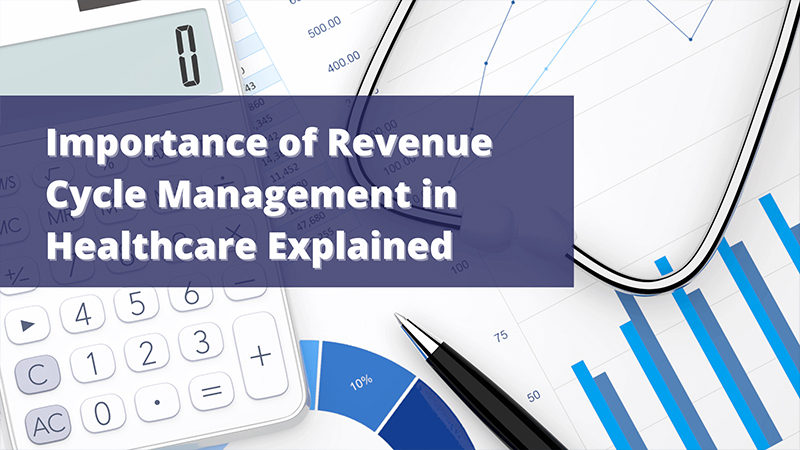Delivering quality care quickly and efficiently is any healthcare provider’s top priority. The reality is that it involves more than just treating the patient. It would help if you also had an effective strategy for managing administrative and clinical functions to ensure that your service providers and the practitioners are adequately compensated for their services—and on time.
If you are a healthcare service provider, the importance of revenue cycle management is central to hassle-free operations for patients and administrative staff, helping you deliver the best possible experience.
Before getting into revenue cycle management benefits, let’s first establish that as a process it’s structured to ensure healthcare facilities and medical practices get paid for the services they provide. It also helps make the reimbursement process as smooth and fast as possible. The importance of revenue cycle management in healthcare cannot stated enough given it applies to every step of your revenue cycle. It begins with an appointment with a given healthcare provider and ends only when all claims and payments, specific to that appointment, have been collected.
You’d think this would be fairly straightforward, but most of the time, it unfortunately is not. There are multiple steps involved with different stakeholders every step of the way. To truly understand the benefits of revenue cycle management one must also understand the flipside—delayed payments, lost of revenue, broken systems. Here’s a quick look at the steps involved in managing your revenue cycle.
5 Steps in Revenue Cycle Management
- Ensure all relevant data generated during patient and staff interaction is synced. This is important because all other steps rely on this data so it’s crucial to ensure it’s carefully generated and maintained
- Next, make sure all services are detailed and properly coded. Given that in charge capturing, physicians and care providers transcribe their services into charges, the reimbursement amount is decided by a universal medical code assigned to each service
- Submit your data to the insurance provider for reimbursement claims
- Make sure to continuously communicate and follow-up with your insurance companies to understand where they are placed in the payment process
- Once your insurance company pays the portion allocated to the services, the remaining balance is sent to the patient for collection
Revenue Cycle Management Benefits
Now that we’ve looked at the process and established the importance of revenue cycle management in healthcare, here are the benefits.
Hassle-Free First Submission Claims
One of the critical goals of revenue cycle management is to complete basic tasks and make sure claims are disbursed after first submission. Some of the basic tasks could include verification, collecting and collating patient information and coding. A large percentage of claims are cleared on the first submission itself. Five to ten per cent of claims are denied on the first submission, and a large percentage of them are denied due to technical issues and human errors.
Increase in Practice Collections and Revenue
Any healthcare facility deals with a number of different expenses. These include paying for the services provided to patients and administrative staff, among others. Managing the facility smoothly is not possible if claims are denied, or patients cannot make payments upfront. The importance of revenue cycle management here is rooted in the ability to uncover specific reasons for claims denial. By analyzing patterns, practices can take corrective steps in the future to receive timely reimbursement.
Refocus Time & Minimize Errors
When a healthcare facility incorporates revenue cycle management, it no longer needs additional time, energy and resources to correct errors and make claims. A combination of skilled professionals and sophisticated technology will contribute to simplifying processes that will in-turn help minimize errors. This way, establishments can refocus valuable time on improving the quality of care delivered to patients.
Enhanced Patient Experience
Efficient revenue cycle management translates into improved overall patient experience. Patients can receive better quality and targeted healthcare which is to reduce re-admittance. Revenue cycle management also eases appointments, billing and form filling by improving all touchpoints involved in the patient experience. It helps create a pleasant experience for both patients and staff. Patients will know their insurance eligibility at the start of their treatment and will not be caught off-guard given the greater emphasis on upfront insurance verification in revenue cycle management.
Reduced Administrative Burden
Your administrative staff are responsible for scheduling appointments, recording and updating patient data, and verifying insurance claims. One of the benefits of revenue cycle management is that all these essential tasks are well-organized and updated allowing administrative staff to perform their duties more efficiently. Additionally, these tasks are completed greater accuracy reducing your chances of claim denials on these grounds.
For over 15 years HelioNext has been assisting healthcare organizations with customizable, end-to-end revenue cycle management and medical billing solutions to drive revenue growth. Outsourcing with HelioNext’s concierge solutions empowers decision makers with complete visibility of their revenue cycle. Contact us to learn more about the importance of revenue cycle management and its benefits.

